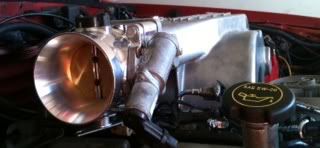Its that way beacause of heat. If it were a straight 5 weight oil it would be even thinner.
Announcement
Collapse
No announcement yet.
differences in oil
Collapse
X
-
For something you are going to be driving under varying conditions use a multi weight. 10/30 has an additive package that makes flow like a 10 weight oil at 100 degrees and like a 30 weight at 210 degrees.Originally posted by bonnie&clyde View Postso which is better for a new engine?
If you use a straight 30 weight it probably won't hurt anything but your oiling system will have to work harder to keep it moving on a cold engine and it'll affect fuel economy.
You want to use the lowest weight possible while still maintaining the proper bearing clearances. I'd feel safer giving up a little economy and performance for some security though.
Personally for a new engine I'd also recommend something with more zinc than what's available in most off the shelf oils. All the OE companies say GF-4 is fine but there sure have been a lot more engine failures since that standard was introduced. Look for something says enhanced ZDDP or something similar. They'll also say "not street legal" since the additives can possibly damage catalytic converters on newer cars.
Comment
-
Flat tappet cams are worse off than OHC and roller designs but they all will suffer from the lack of zinc/phosphates. It was removed strictly for emissions purposes, the EPA could care less about reliability so it wasn't even a consideration once the big 3 signed off on the new spec.Originally posted by 91CoupeMike View PostI thought the zinc additives were more for engines with flat tappet where if try and break it in it will cause the cam to go flat?
Does that still hold true for hydraulic cams?
Kind of like ULSD, lots more injector pump wear as a result but since all the diesel manufacturers say it's okay we'll have to live with the specification and increased pump wear.
Comment
-
Looks like all the oils have more viscosity at 40c then 100c. pours like a 30 and protects like a 10 when hotOriginally posted by TENGRAM View PostCheck the data sheets here: http://www.bobistheoilguy.com/aehaas/oildatasheets.html
The difference is just in how the oil viscosity is rated... the operating ranges are different. If you had an engine built, your builder should recommend the correct oil. If it is a new car then you should go by whatever the owner's manual says. This is not the area where you want to experiment.
Comment
-
Viscosity is a measurement of a fluids resistance to flow. Its flowed and 210deg f through an orifice and measured by a viscometer and graded on a sae points scale. A 10w30 flows the same at 210deg as straight 30w but the 10w30 has less resistance to flow at lower temps. Its to prevent dry start ups on modern engine designs with much tighter clearances.89 dove grey lx, turbo blowthrough
Comment
-
That's what I said, but in English.Originally posted by turbos66coupe View PostViscosity is a measurement of a fluids resistance to flow. Its flowed and 210deg f through an orifice and measured by a viscometer and graded on a sae points scale. A 10w30 flows the same at 210deg as straight 30w but the 10w30 has less resistance to flow at lower temps. Its to prevent dry start ups on modern engine designs with much tighter clearances.
Comment
-
Researched
At cold temperatures, the polymers are coiled up and allow the oil to flow as their low numbers indicate. As the oil warms up, the polymers begin to unwind into long chains that prevent the oil from thinning as much as it normally would. The result is that at 100 degrees C, the oil has thinned only as much as the higher viscosity number indicates. Another way of looking at multi-vis oils is to think of a 20W-50 as a 20 weight oil that will not thin more than a 50 weight would when hot.
I'll stfu now
Comment
-
We have a winnerOriginally posted by garycrist View Post10W-30 means it is a 10 weight motor oil PERIOD! W is the winter or cold pourability.
the end number 30 means the oil will thin down an equal to what a 30 weight would thin down at operating temps.
If a straight 30 weight oil thins down say 4 viscosity points then your 10 weight is now 6.
Oil doesn't thicken up when hot!
Comment
-
NO...the higher the number rating the more resistance to flow an oil has. Correct on the additives, they re called pour point depressants and they are used to keep the oil in this "thinner" state when its cold. Same reason why guys used to put a higher numbr oil like 20w-50 in an old engine to reduce clatter. The heavier oil doesn't flow back to pan as fast it clings to things. With modern engine designs and the use of more materials like aluminum and polymers that disapate heat rapidly and much tighter engine clearances has kind of brought way for lighter viscosity oils and the lighter oils reduce engine drag thus making them more efficient. That is why most oils rated 5w-30 and below have an energy conserving rating on the back lower corner of the bottle.89 dove grey lx, turbo blowthrough
Comment
-
What about buying those additives that put the zinc and stuff back in? You just pour a little in with every oil change I think.Originally posted by BP View PostKind of like ULSD, lots more injector pump wear as a result but since all the diesel manufacturers say it's okay we'll have to live with the specification and increased pump wear.
Comment


Comment